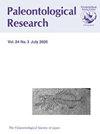奥陶纪生物多样性大事件(GOBE)不是一个单一的事件
IF 0.6
4区 地球科学
Q3 PALEONTOLOGY
引用次数: 36
摘要
摘要奥陶纪生物多样性被认为是整个显生宙海洋生态系统中最重要的辐射之一。最初被认为是“奥陶纪辐射”,这个标签在20世纪80年代和90年代的大部分时间里都保留着,“大奥陶纪生物多样化事件”(GOBE)一词是在20世纪90年代末创造的,随后被大多数科学界采用。奥陶纪生物多样性一直被认为是一种长期的适应性辐射,它导致了整个奥陶纪不同时期海洋生物群不同个体多样性的总和。最近,根据不同的古生物学数据集,包括来自不同古地理区域的数据,奥陶纪辐射被解释为在不同的时间、不同的地方发生。这很可能与奥陶纪的古地理有关,当时主要的古大陆位于不同的低纬度地区,以在不同的时间间隔内形成生物多样性的“热点”。特别是,一些作者使用古生物学数据库(PBDB)的潜在偏见数据集,认为GOBE是中奥陶世早期的全球生物事件。因此,GOBE显然对应于一个相对较短的时间间隔,多样性的剧烈波动导致全球范围内海洋环境的深刻变化,世界各地所有化石群的生物多样性都出现了重大变化。对公布的生物多样性曲线和我们自己的数据的批判性分析证实了传统观点;奥陶纪辐射是一个复杂、长期的海洋生物多样性过程。在区域或古大陆层面,特别是在有限的数据集内,可以发现一些化石群的多样性迅速增加。然而,在特定的时间间隔内,一个短暂而戏剧性的事件在全球范围内引发了所有化石群的主要生物多样性脉冲,这是一个过于简单化的说法。本文章由计算机程序翻译,如有差异,请以英文原文为准。
The Great Ordovician Biodiversification Event (GOBE) is Not a Single Event
Abstract. The Ordovician biodiversification is considered one of the most significant radiations in the marine ecosystems of the entire Phanerozoic. Originally recognized as the ‘Ordovician Radiation’, a label retained during most of the 1980s and 1990s, the term ‘Great Ordovician Biodiversification Event’ (GOBE) was coined in the late 1990s and was subsequently adopted by most of the scientific community. The Ordovician biodiversification, has always been considered as a long-term adaptive radiation, resulting in the sum of the different individual diversifications of all groups of marine organisms that occurred diachronously during the entire Ordovician. More recently, based on different palaeontological datasets, comprising data from different palaeogeographical areas, the Ordovician radiation has been interpreted to occur at different times in different places. This is most probably related to the palaeogeography of the Ordovician, when the major palaeocontinents were variously located in low latitudes to develop biodiversity ‘hotspots’ during different time intervals. In particular, some authors, using the potentially biased dataset of the Paleobiology Database (PBDB), have considered the GOBE to be an early Middle Ordovician global bio-event. Accordingly, the GOBE thus apparently corresponds to a relatively short time interval, with dramatic diversity fluctuations resulting in a profound change in marine environments at a global scale, visible by a major pulse in biodiversification of all fossil groups around the world. A critical analysis of the published biodiversity curves and of our own data confirm the traditional view; the Ordovician radiation is a complex, long-term process of multiple biodiversifications of marine organisms. Rapid increases in diversity can be identified for some fossil groups, at regional or palaeocontinental levels, in particular within limited datasets. However, a short, dramatic event that triggered major biodiversity pulses of all fossil groups at a global level at a particular time interval is an oversimplification.
求助全文
通过发布文献求助,成功后即可免费获取论文全文。
去求助
来源期刊

Paleontological Research
PALEONTOLOGY-
CiteScore
1.60
自引率
0.00%
发文量
47
审稿时长
>12 weeks
期刊介绍:
Paleonotological Research (PR) is a quarterly, peer-reviewed international journal, which focuses on original contributions primarily in the area of paleontology but also covering a wide range of allied sciences. It has been published since 1997 as a successor to the former journal Transactions and Proceedings of the Palaeontological Society of Japan. The emphasis of contributions will include global and local perspectives, and contents can cover all ages (Precambrian to the Quaternary, including the present time).
 求助内容:
求助内容: 应助结果提醒方式:
应助结果提醒方式:


